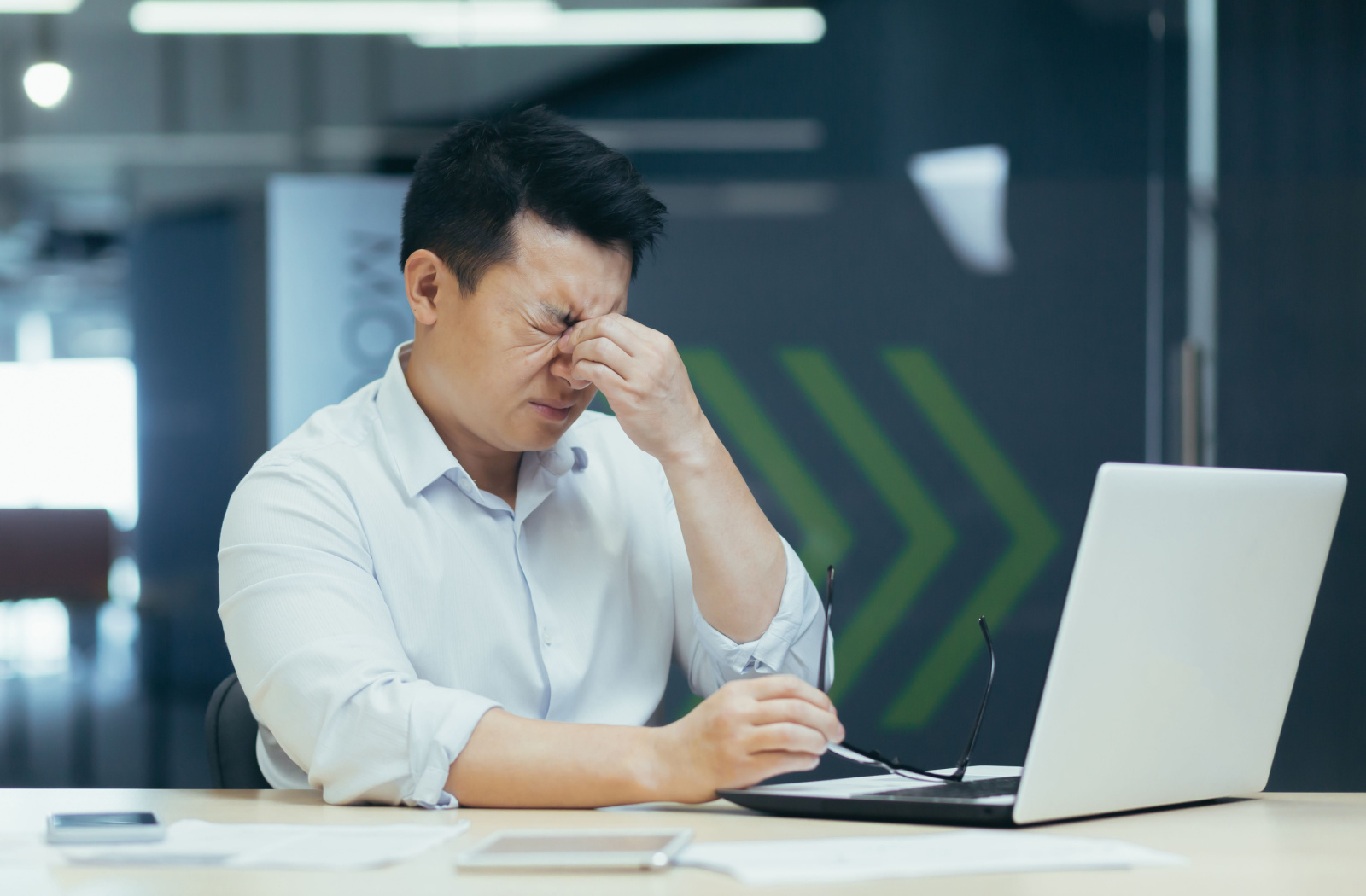Most of us have had at least one headache at some point. There is more than one type of headache, each varying in location, intensity, frequency, and cause. Common types include migraines, tension headaches, and cluster headaches.
Another common type of headache is an eye strain headache. These tend to be much milder than migraines or tension headaches. A few key characteristics, such as decreased pain with rest, no digestive upset, and pain right behind the eyes, set an eye strain headache apart from others.
Eye strain is typically temporary, and its symptoms subside after resting your eyes. But, if you experience frequent eye strain symptoms, there could be more at work than simply spending too much time on a computer. You should see your eye doctor for a comprehensive eye examination to rule out any underlying causes, like an inaccurate eyeglass prescription.
What Is Eye Strain?
Eye strain is a condition caused by intense use of the eyes. It sometimes goes by other names like eye fatigue or asthenopia. Any activity that requires intense focus, such as reading, sewing, or driving, can cause eye strain. But another common cause is the prolonged use of digital devices.
Eye strain that develops with digital device use is called digital eye strain or computer vision syndrome. Even if you experience digital eye strain, you don’t have to get rid of screen time permanently—for many people, that’s impossible—but it may require a change in routine.
Symptoms of Eye Strain
Eye strain can cause several uncomfortable symptoms, both eye-related and non-eye-related.
Eye-related symptoms include:
- Excessive eye watering
- Dry, itchy eyes
- Burning sensation
- Blurry vision
- Light sensitivity
- Trouble keeping your eyes open
Non-eye-related symptoms include:
- Neck, shoulder, or back pain
- Trouble concentrating
- Headaches
What Does an Eye Strain Headache Feel Like?
You can tell when you have an eye strain headache because it usually starts hurting after spending a prolonged time using a digital screen or doing other tasks requiring intense focus. Headaches from eye strain are generally less painful than migraines or cluster headaches. If you have experience with other types of headaches, then you may notice the difference.
If the pain is directly behind your eyes and you don’t have nausea or vomiting, you likely have an eye strain headache.
How Long Do Eye Strain Symptoms Last?
There isn’t a one-size-fits-all answer to how long eye strain lasts because it varies from person to person. Eye strain generally doesn’t last very long. But if you experience other symptoms at the same time, such as sore back, shoulders, or a headache, it may take longer to resolve.
Eye strain shouldn’t last for days. So, if you’re experiencing persistent symptoms that don’t respond to rest, over-the-counter pain medication, or eye drops, it’s a good idea to see your optometrist.
Getting Relief from Eye Strain
Eye strain, whether caused by digital devices or other intense uses of your eyes, doesn’t go away simply by taking medication. Treating eye strain primarily involves removing whatever is causing it and preventing your eyes from becoming over-tired in the first place.
Some things you can try to relieve your eye strain symptoms include:
- Take a break from whatever you’re doing that’s causing the strain, and let your eyes rest.
- Change your environment, whether the lighting, eliminating glare, or adjusting your computer screen angle or height.
- Wear up-to-date prescription glasses to help minimize how hard your eyes must work to focus.
- Blink often and use lubricating eye drops to keep your eyes hydrated and fresh. Using preservative-free eyedrops for long-term use is a good idea to avoid additional eye irritation.
Preventing Eye Strain
While not always 100% possible, prevention is key. Some things you can do to prevent eye strain include:
- Practice the 20-20-20 rule. Every 20 minutes, take 20 seconds to look at something 20 feet away. This break allows your eyes to refocus and rest from the intense up-close focus.
- Ensure your workspace is set up in a way that minimizes eye fatigue. Keep your computer screen or TV approximately arm’s length away and position it below eye level. Not every situation is the same. Talk to your optometrist if you need suggestions on how to customize your space to improve your eye health.
- Use a humidifier to add moisture to dry environments.

Discuss Your Symptoms with Your Eye Doctor
Ultimately, there isn’t a magic answer to preventing eye strain, how long the symptoms might last, or getting rid of the symptoms. Fortunately, the symptoms typically resolve on their own in a reasonable timeframe.
But there may be an underlying cause contributing to your discomfort if your eyes are constantly tired and you’re experiencing these uncomfortable symptoms. Call us at Dr. Bishop & Associates to schedule an appointment. Our experienced optometrists can review your symptoms and examine your eyes to rule out any underlying reasons for your eye strain.


















